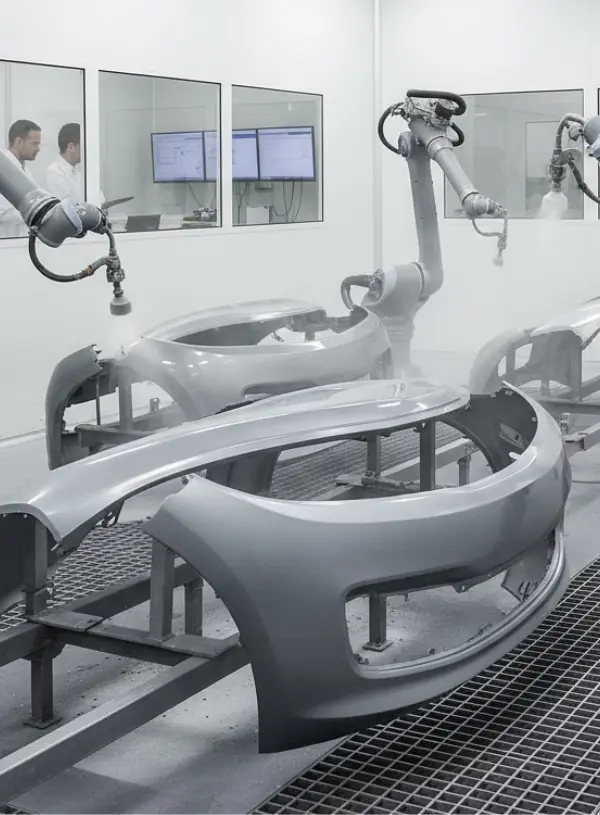Primer-Reduced Painting of TPO Bumpers
Activating low-surface-energy TPO with air-plasma pretreatment to enable durable paint adhesion while cutting solvent primers and prep time.
Automotive bumpers made from TPO (thermoplastic polyolefin) have a dirty secret: They hate paint.
Their slippery, low-energy surfaces force manufacturers into a chemical wrestling match involving solvent-based primers, extensive prep work, and crossed fingers at quality control. Every peeling bumper that rolls off the line represents wasted materials and potential warranty claims that can run thousands per vehicle.
The stakes multiply when you consider VOC regulations tightening across states, disposal costs climbing, and production lines slowing to accommodate multiple primer coats.
Yet TPO remains the material of choice for bumpers - it's lightweight, impact-resistant, and affordable. The challenge isn't replacing TPO; it's making paint stick to it without drowning your process in expensive, harsh chemicals.
If you don’t want to learn about this and you just want the plasma treater we built for painting TPO bumpers, you can submit for a quote in 20 seconds.
Why don't paints adhere to untreated TPO surfaces?
TPO's surface energy typically measures between 29-31 dynes/cm - well below the 40+ dynes/cm threshold needed for paint to properly wet and bond to a surface. Think of it like trying to write on a greasy plate with a ballpoint pen. The ink beads up and slides around because there's nothing for it to grab onto.
The molecular structure compounds this problem. TPO's hydrocarbon chains offer no functional groups - no oxygen, no nitrogen, nothing that paint molecules recognize as a bonding site. It's chemically indifferent to your coating system.
Traditional workarounds have included…
- Multiple coats of solvent-based adhesion promoters.
- Flame treatment that risks warping or inconsistent coverage.
- Manual sanding that generates dust and varies by operator.
- Chemical etching that creates hazardous waste streams.
Each approach trades one problem for another - adding time, cost, environmental burden, or quality variability to your process.
Ask for a demo to see it work with your TPO bumpers
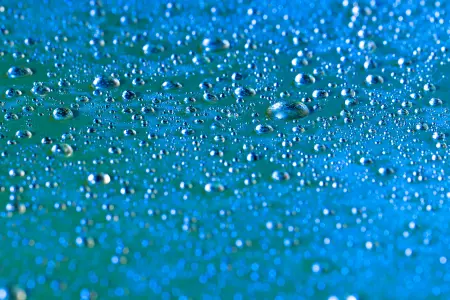
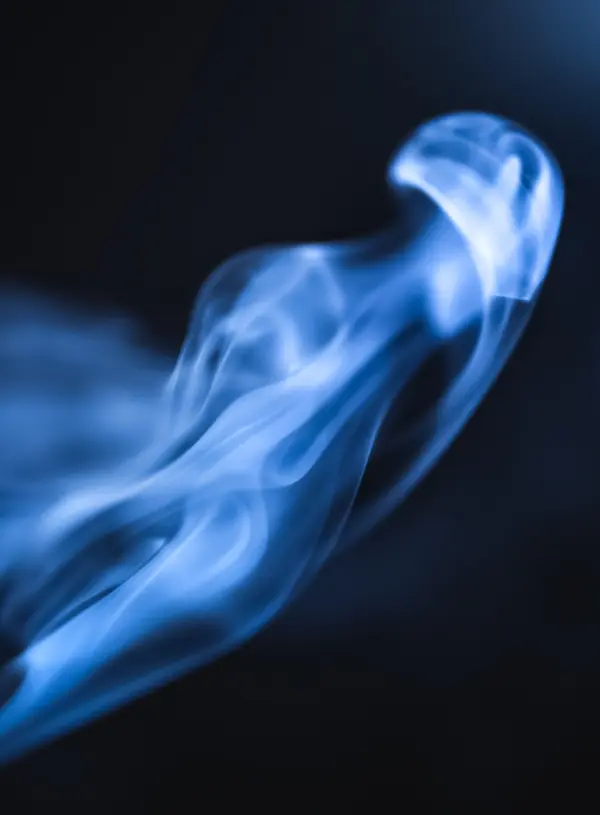
How does atmospheric plasma treatment solve TPO paint adhesion?
Plasma treatment fundamentally changes the TPO surface at the molecular level.
The ionized air stream breaks carbon-hydrogen bonds and introduces oxygen-containing functional groups - carbonyls, hydroxyls, carboxyls - creating actual chemical bonding sites where none existed before.
Surface energy jumps from that problematic 29-31 dynes/cm range to 42-50 dynes/cm within seconds of treatment. Paint molecules now find a surface they can wet, spread across, and chemically bond with. The transformation happens at room temperature, without contact, without consumables beyond compressed air and minimal electricity.
The plasma stream also performs micro-cleaning, removing mold release agents, processing oils, and other contaminants that interfere with adhesion. You're simultaneously activating and cleaning the surface in a single pass.
How much surface energy is actually needed for automotive paint adhesion?
The magic number sits around 40 dynes/cm minimum, but the target depends on your specific coating system. Water-based paints typically need higher surface energy (42-45 dynes/cm) than solvent-based systems. Clear coats and metallic finishes may require even higher activation levels.
Yamato's plasma treater machines consistently achieve 42-50 dynes/cm on TPO surfaces - providing a comfortable margin above minimum requirements. This buffer matters in production environments where minor variations in material composition or processing conditions could otherwise lead to adhesion failures.
Verification takes seconds with dyne testing pens or contact angle measurements. Unlike flame treatment where results vary across the surface, plasma treatment delivers uniform activation you can measure and document for quality records.
Get a demo and validate adhesion this week
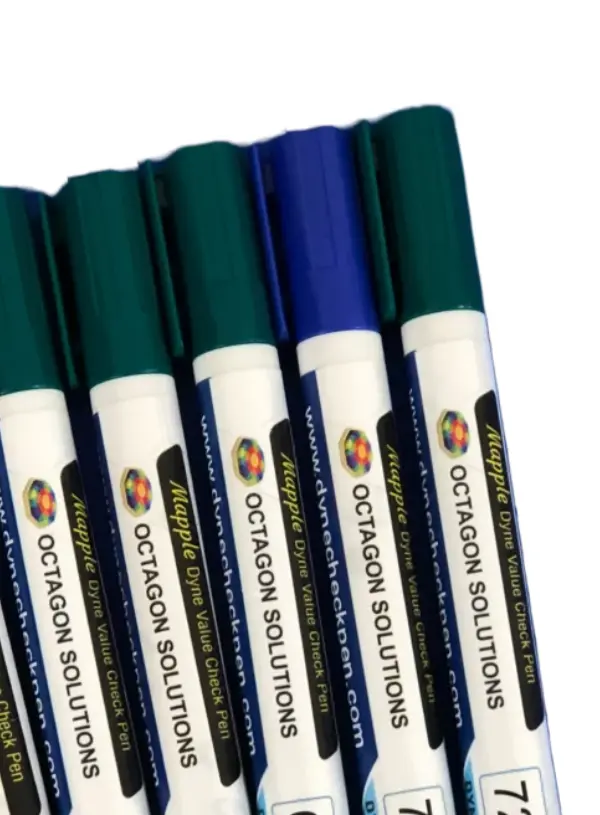
Does plasma treatment completely eliminate the need for primers on TPO?
It depends on your paint system and quality requirements. Many manufacturers eliminate primers entirely when switching to plasma pretreatment. Others reduce from multiple primer coats to a single thin layer, or switch from solvent-based to water-based primers.
Key factors that determine primer requirements:
Paint chemistry and manufacturer specifications.
Required durability standards (UV exposure, chemical resistance, impact).
Color and finish type (metallics and pearls may need different approaches).
Production speed and cure parameters.
Even when primers remain necessary, plasma treatment allows you to use less aggressive, lower-VOC formulations. The activated surface provides better mechanical interlocking and chemical bonding, reducing your reliance on primer chemistry to bridge the adhesion gap.
Why choose Yamato's plasma treater for automotive bumper applications?
Yamato's atmospheric plasma system addresses the specific challenges of bumper production lines. The adjustable treatment head accommodates varying bumper geometries - from simple fascias to complex designs with integrated sensors and vents. Programmable intensity and dwell time settings ensure reproducible treatment across different TPO formulations and thicknesses.
The non-contact design eliminates risks associated with flame treatment.
No thermal distortion on thin sections.
No operator burn hazards.
No natural gas consumption or open flames near paint booths.
Consistent coverage even on complex curves and recesses.
Integration happens inline, directly before your paint booth. The compact footprint - smaller than most primer flash-off tunnels - actually reduces your line length while improving throughput. Treatment occurs at line speed with no additional drying or flash-off time required.
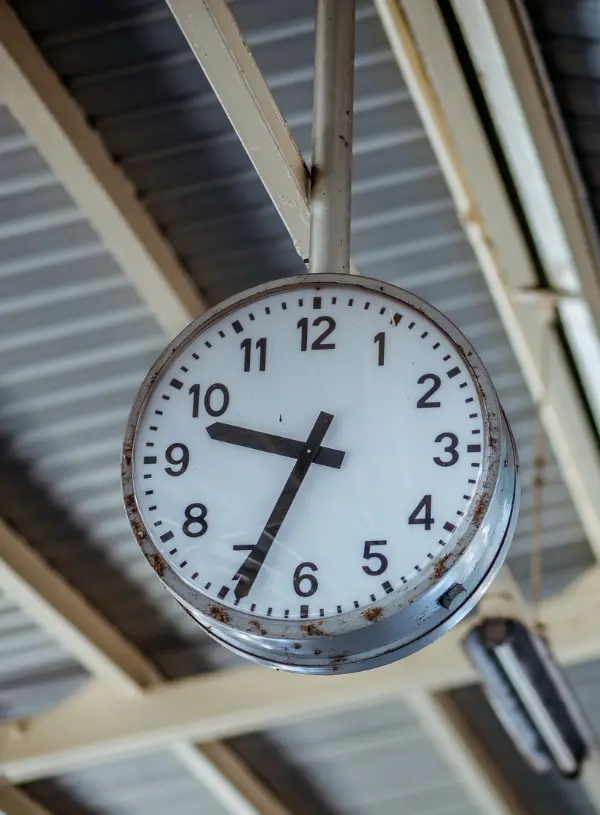
How long does the plasma-treated surface remain paint-ready?
TPO surfaces begin recovering their hydrophobic character within hours of treatment, but the practical paint window extends much longer than most production scenarios require. With inline integration, you're painting within seconds or minutes of treatment - well within the optimal adhesion window.
Studies show:
- Maximum adhesion: 0-30 minutes post-treatment.
- Acceptable adhesion: 30 minutes to 4 hours.
- Degraded adhesion: Beyond 4-6 hours (varies by storage conditions).
Humidity and temperature affect recovery rates. Climate-controlled environments extend the treatment window, while high humidity accelerates hydrophobic recovery. But since plasma units integrate directly with paint lines, this timing rarely becomes a limiting factor.
Get your plasma treater machine quote within 48 hours
What environmental benefits result from reducing primer use with plasma?
Cutting primer consumption delivers measurable environmental wins beyond simple VOC reduction. Consider the full lifecycle impact.

VOC emissions
Cutting primer consumption delivers measurable environmental wins beyond simple VOC reduction. Consider the full lifecycle impact.

Hazardous waste
Less primer means less sludge, fewer contaminated filters, reduced booth cleaning chemicals.

Energy consumption
No primer flash-off ovens running at 140-180°F for 10-15 minutes per coat.

Transportation emissions
Fewer primer deliveries, less hazardous material shipping.

Worker exposure
Reduced handling of isocyanates and other primer components.
Plasma treatment uses only compressed air and electricity - no consumables, no waste stream, no disposal costs. The same unit runs for years with minimal maintenance beyond occasional electrode cleaning.
How does plasma treatment compare to other TPO activation methods?
Each pretreatment method involves trade-offs. Here's how atmospheric plasma stacks up:
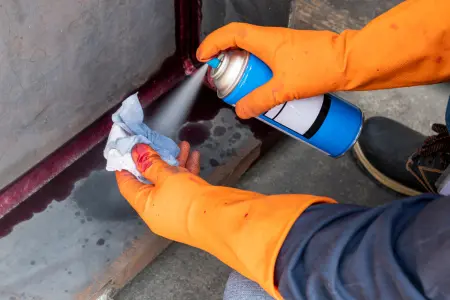
Versus Solvent Primers.
Plasma wins on speed (seconds vs. minutes), environmental impact (zero VOCs), and operating cost (air and electricity vs. chemicals and disposal). Primers still edge out plasma for extreme durability requirements in some specialized applications.
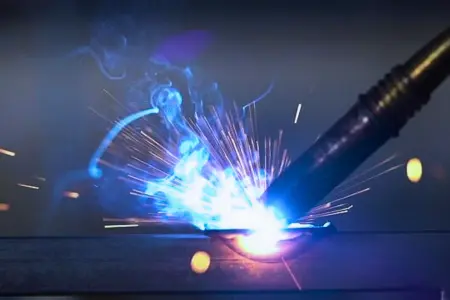
Versus Flame Treatment.
Plasma provides more consistent, controllable activation without thermal risks. Flame treatment costs less upfront but carries higher safety and quality risks. Plasma's programmable parameters ensure reproducibility that flame treatment can't match.
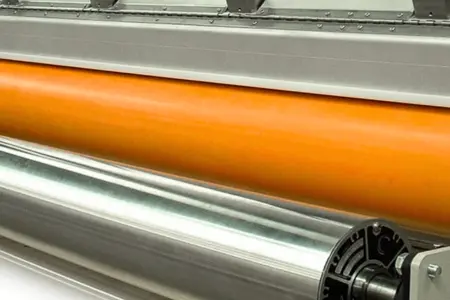
Versus Corona Treatment.
Corona works well for films and flat surfaces but struggles with 3D parts like bumpers. Plasma handles complex geometries, provides deeper treatment penetration, and doesn't require the close proximity that corona demands.
What quality control methods verify proper plasma activation?
Documenting surface activation provides both process control and warranty protection. Standard verification methods include…
Dyne testing. Calibrated test inks spread on treated surfaces, confirming energy levels.
Contact angle measurement. Water droplet analysis quantifies surface wettability.
Cross-hatch adhesion testing. ASTM D3359 standard for coating adhesion.
Tape pull tests. Quick production-floor verification of treatment effectiveness.
Yamato's systems support integration with automated inspection systems. Treatment parameters log automatically, creating quality records that trace each bumper through your process. When a customer questions paint durability three years later, you have the data.
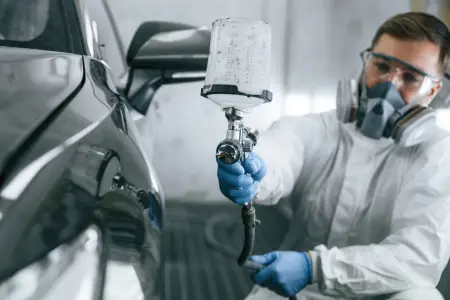
What's the real ROI for automotive manufacturers switching to plasma?
The economics extend beyond primer savings. A mid-size operation processing 2,000 bumpers daily might see…
- Primer reduction: $2-4 per bumper
- Solvent disposal: $0.50-1 per bumper
- Energy (no flash-off ovens): $0.30-0.50 per bumper
- Labor reduction: 0.5-1 minute per bumper
- Fewer paint defects reducing rework (typically 3-5% improvement)
- Faster line speed (no primer flash-off time)
- Reduced warranty claims from adhesion failures
- Simplified environmental compliance
*The numbers above are illustrative. Yours will vary.
Typical payback periods run 8-14 months depending on volume and current primer costs. The equipment operates for 10+ years with minimal maintenance, delivering long-term value beyond initial ROI calculations.
Practical implementation.
How to integrate plasma treatment into existing bumper lines
Successful plasma integration follows a predictable path:

Surface energy mapping
Test your specific TPO formulation to establish baseline and target values.

Parameter development
Determine optimal power settings, working distance, and traverse speed for your parts.

Line integration
Position the plasma unit after deflashing/cleaning, before paint application

Verification protocol
Establish dyne testing or contact angle measurement at regular intervals.

Training
Operators need minimal training - no chemical handling, just parameter monitoring.
Common integration points.
- After parts cooling/deflashing.
- Before primer application (when primer remains in use).
- Immediately before base coat application.
- Before clear coat on pre-painted parts requiring repair.

Can plasma treatment improve adhesion for other automotive coatings?
The surface activation that helps paint adhesion extends to other coating challenges.
Clear coats: Better flow-out and adhesion, reducing orange peel
Vinyl wraps and decals: Stronger initial tack and long-term adhesion
Protective films: Paint protection films bond better to plasma-treated surfaces
Chrome and metallic finishes: Improved adhesion of vacuum-deposited coatings
Rubber seals and weatherstripping: Better adhesion of EPDM and TPE components
One plasma unit can serve multiple applications, treating bumpers, trim pieces, and other TPO components passing through your paint shop.
Key Takeaways for TPO Bumper Painting with Plasma Treatment
Atmospheric plasma treatment transforms TPO bumper painting from a primer-intensive struggle to a streamlined, reproducible process. The technology delivers immediate surface activation - raising energy from 29-31 to 42-50 dynes/cm - while eliminating or dramatically reducing primer requirements.
For automotive manufacturers, this means…
Cutting VOC emissions by 30-50 grams per bumper.
Reducing primer costs by $2-4 per unit.
Eliminating primer flash-off time from production cycles.
Achieving consistent, measurable surface activation.
Protecting against warranty claims from adhesion failures.
Yamato's plasma treaters integrate directly into existing lines with minimal footprint, no thermal risks, and programmable parameters that ensure batch-to-batch consistency. The switch from chemical to physical surface preparation aligns with both environmental regulations and lean manufacturing principles.
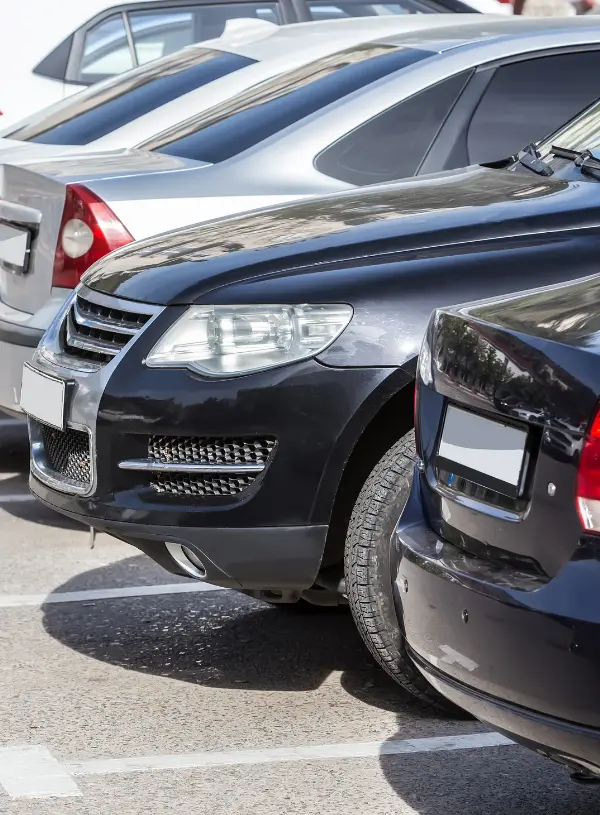
Ready to calculate the specific ROI for your bumper production line? Get in touch with us for plasma treater application testing and a customized integration proposal that quantifies savings in primer, labor, energy, and rework for your exact production scenario.
